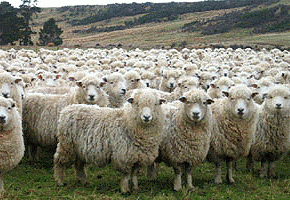
By Allan Barber
 After some harrowing experiences last season for the meat industry, both processors and farmers, 12 months on things are looking up.
After some harrowing experiences last season for the meat industry, both processors and farmers, 12 months on things are looking up.
This sense of optimism hasn’t yet been reflected in prices from the meat companies, but statements from those in the know strike a perceptibly more positive note.
Last year the lamb kill was down by a million, there was drought in significant livestock areas, the dollar was too high and so was the procurement price for lamb.
While beef remained relatively unaffected by the hype, the price really not changing much in a year, sheep meat was a completely different story.
Driven by the unholy combination of scarcity and tight shipping deadlines for the Christmas trade, the procurement price hit $8 a kilo and struggled to get down from that level.
The net result was too many buyers chasing too few lambs which were also allowed to put on too much weight.
The export markets got a severe dose of indigestion and inevitably inventories built up fast on both sides of the world. All this time the NZ dollar stayed obstinately high.
We will find out in November how badly this set of circumstances affected the profit and balance sheet performance of the meat exporters, although Blue Sky’s result to the end of March gave a pretty good indication of the effect of the first six months of the season.
Farmers won’t be as unhappy as the processors and exporters because they received more for their stock than it was worth and, although the lamb price has now dropped from $150 to below $100, this is still better than in many previous years.
According to Keith Cooper in Silver Fern Farms’ news release last week, he predicts the price will bottom out at about $4.80 per kilo after Christmas, equivalent to $90 for an 18.75 kg lamb. It will then rebuild to $5.80 or $109 by this time next year.
Cooper has also said last year’s pricing got way out of kilter and won’t happen again this year.
Cooper’s optimism is based on favourable European buyer response in the last couple of weeks, culminating in the European food fair at SIAL in Paris last weekend.
UK supermarket chains also seem to be positive about the forthcoming chilled New Zealand lamb season which starts with Christmas and continues until British lamb starts to appear in the chillers after Easter.
SFF’s news release provided an interesting, if slightly puzzling, piece of information which stated that Marks & Spencer had awarded their new contract for chilled lamb to Alliance, having dealt exclusively with SFF for five years, because “we could not offer Organic lamb to M&S.” As far as I can understand and from memory, M&S have always insisted on knowing where their lamb came from, eventually insisting on identifying the lambs’ farms of origin and traceability, but organics have never been a requirement in the past.
Cooper subsequently confirmed to me that the M&S tender specified a proportion of organic supply as part of the supply which SFF couldn’t guarantee to fulfil.
Alliance suggested that it was not required to supply certified organic lamb under its new contract, although all suppliers involved belong to the company’s Hoofprint programme which measures their carbon footprint. In fact it’s hard to see how enough organic lamb could be available, especially in the pre Christmas period, while there is little evidence the UK supermarkets are willing to pay a sufficient premium for organic supply.
In contrast beef prices appear set to continue stable, underpinned by drought conditions which have affected feed supply and cost in the USA; however any weakness in the New Zealand dollar would inevitably flow through to better livestock prices, much as meat companies might want to hang onto any bonus they receive.
I imagine meat exporters will be keen to put what was reasonably torrid 2011/12 season behind them and bed in the capacity changes they have decided on, so their new season’s performance can benefit.
Sheep farmers can’t aspire to the $150 lamb, but they can expect more certainty and consistency on which to base their farm business.
--------------------------------------------
Allan Barber is a commentator on agribusiness, especially the meat industry, and lives in the Matakana Wine Country where he runs a boutique B&B with his wife. You can contact him by email at allan@barberstrategic.co.nz or read his blog here »

We welcome your comments below. If you are not already registered, please register to comment
Remember we welcome robust, respectful and insightful debate. We don't welcome abusive or defamatory comments and will de-register those repeatedly making such comments. Our current comment policy is here.